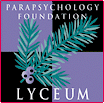 |
 |
| Click here for the PF Lyceum Site Index
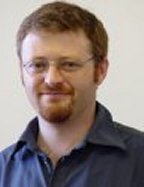
PF Lyceum Blog #7, February 2nd, 2006 José M. Pérez-Navarro, Ph.D. For a biography of our guest blogger, Dr. Pérez-Navarro, click here. “ESP” (Extrasensory Perception) is described as a way of communicating with or of being aware of things, people, and events without the use of the common known senses. The term has been attributed to Sir Richard Burton in the 1870s, although Gustav Pagenstecher (Pagenstecher, 1924) made a more concrete use of the term. Other authors, such as Dr. Rudolph Tischner in the 1920s, also used this concept to describe a form of “externalization of sensibility.” ESP phenomena are traditionally classified into three categories. These are: (1) telepathy, understood as the awareness of the thoughts or feelings of another person; (2) clairvoyance, or awareness of objects, events, or people without the use of the known senses; and (3) precognition, or the knowledge of future events. The first studies of ESP were conducted in the 1880s. This early work consisted mostly of investigations of cases and “gifted” individuals. The study of ESP progressed, becoming more and more scientific in the first quarter of the century. It was in the 1930s when J. B. Rhine conducted a series of experiments at Duke University which called the attention of the scientific community to the research. 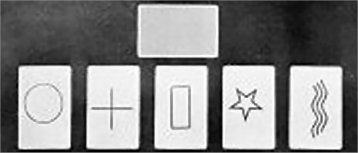 Rhine conducted some of the first systematic and long term studies of ESP under controlled experimental conditions. He used a forced-choice card-guessing technique. These cards, known as “Zener cards”, consisted of five symbols: a star, a circle, a square, a plus sign, and a set of wavy lines. In each deck of 25, each symbol was repeated 5 times each. The participants of Rhine’s experiments were asked to try to guess the order of the symbols when they were shuffled. The likelihood of guessing a card correctly just by mere chance was one in five. However, after conducting a large number of trials, Rhine observed that the percentage of cards correctly guessed by his participants was significantly higher than this expected value. Rhine concluded that this fact indicated that participants somehow achieved awareness of the order of the cards through some form of non-sensory mechanism. (Click here for some on-line ESP experiments that you can try out for yourself.) Rhine conducted some of the first systematic and long term studies of ESP under controlled experimental conditions. He used a forced-choice card-guessing technique. These cards, known as “Zener cards”, consisted of five symbols: a star, a circle, a square, a plus sign, and a set of wavy lines. In each deck of 25, each symbol was repeated 5 times each. The participants of Rhine’s experiments were asked to try to guess the order of the symbols when they were shuffled. The likelihood of guessing a card correctly just by mere chance was one in five. However, after conducting a large number of trials, Rhine observed that the percentage of cards correctly guessed by his participants was significantly higher than this expected value. Rhine concluded that this fact indicated that participants somehow achieved awareness of the order of the cards through some form of non-sensory mechanism. (Click here for some on-line ESP experiments that you can try out for yourself.)
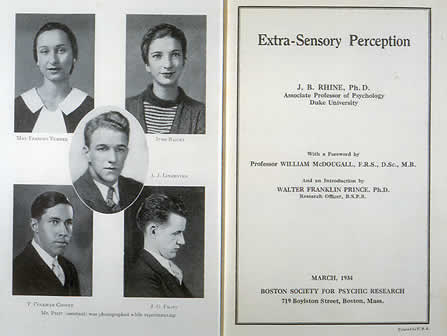 This work was published by Dr. Rhine in 1934 in a monograph titled Extra-Sensory Perception. Dr. Rhine’s work had a marked impact on the scientific community and work in the area began to proliferate. Up to 1940 over a hundred ESP experiments were published. Most of these studies obtained findings beyond those expected by statistical chance. Such a level of success lead Rhine and his laboratory staff members J. Gaither Pratt, Charles Stuart, Burke M. Smith and Joseph A. Greenwood to publish a book called Extra-Sensory Perception After Sixty Years, which summarized and discussed these findings as well as the criticisms raised by skeptical scientists. This work was published by Dr. Rhine in 1934 in a monograph titled Extra-Sensory Perception. Dr. Rhine’s work had a marked impact on the scientific community and work in the area began to proliferate. Up to 1940 over a hundred ESP experiments were published. Most of these studies obtained findings beyond those expected by statistical chance. Such a level of success lead Rhine and his laboratory staff members J. Gaither Pratt, Charles Stuart, Burke M. Smith and Joseph A. Greenwood to publish a book called Extra-Sensory Perception After Sixty Years, which summarized and discussed these findings as well as the criticisms raised by skeptical scientists.
Some theorists argue that ESP is the remnant of an ancient sense which has deteriorated in human beings as their cultures have developed. Conversely, other theorists claim that ESP is a “supersense” which evolved in the nervous system. There are also speculations that some people (psychics) are born with this gift. However, research supports that everyone is born with ESP capability, although some may possess more than others. This is reinforced by the fact that, according to survey work, most people report having experienced ESP at least once in their lives. (For a bibliography on theories of extra-sensory perception click here.) One of the first theories on the nature and functioning of ESP was put forward by Frederic W. H. Myers in his Human Personality and Its Survival of Bodily Death published in 1903. This author described ESP in terms of a particular functioning of perception that occurred below the threshold of consciousness. Myers realized that a large number of the reported cases of ESP occurred while percipient were experiencing an altered state of consciousness. He suggested that this phenomenon could be most noticeable in dreams, trance states, or hypnosis. Laboratory studies on dream ESP, such as the Maimonides dream telepathy study, as well as hypnosis studies (see e.g. Krippner, 1970, 1993) have produced sound evidence for ESP. (Both the original PF monograph on dream telepathy and the reprint of the book on the Maimonides work are available on the PF’s on-line store. Click here and put “dream telepathy” in the search box.) 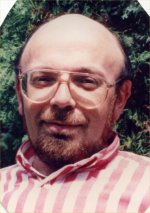 In the 1970s Charles Honorton proposed the Noise Reduction Model (Honorton, 1974, 1977) which theorized that ESP was a weak “signal” masked by external and internal (mental and physiological) stimuli (noise). Thus reducing the surrounding and internal stimulation would increase the signal-to-noise ratio providing the percipient a greater chance of detecting any ESP “signal” present. One reason why ESP is frequently observed during altered states of consciousness (e.g., dreaming or hypnosis) is that the conscious mind is less active under these conditions, therefore, producing less mental “noise” that covers up the ESP signal. Following this line of reasoning and a series of experimental findings, Honorton adapted the Ganzfeld technique to the study of ESP. In the 1970s Charles Honorton proposed the Noise Reduction Model (Honorton, 1974, 1977) which theorized that ESP was a weak “signal” masked by external and internal (mental and physiological) stimuli (noise). Thus reducing the surrounding and internal stimulation would increase the signal-to-noise ratio providing the percipient a greater chance of detecting any ESP “signal” present. One reason why ESP is frequently observed during altered states of consciousness (e.g., dreaming or hypnosis) is that the conscious mind is less active under these conditions, therefore, producing less mental “noise” that covers up the ESP signal. Following this line of reasoning and a series of experimental findings, Honorton adapted the Ganzfeld technique to the study of ESP.
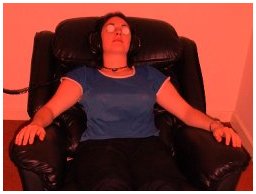 The Ganzfeld is the experimental procedure most successfully used nowadays in ESP studies. It consists of a sensory attenuation technique originally used in the study of perception. In a standard ESP Ganzfeld experiment two participants take part, one acts as a telepathic “sender” while the other acts as a “receiver.” The sender is asked to “communicate silently” the characteristics and meaning of a visual stimulus (e. g. an art print or a video clip) to the receiver. In the meantime the receiver, resting comfortably on a reclining chair in a distant room, reports mental imagery and subjective impressions that he or she experiences. The receiver’s mentation is usually recorded for later analysis. Sensory attenuation is achieved by playing white random noise via headphones plus a red light is projected on two acetate covers on his or her eyes. This exercise lasts approximately 30 minutes. Then the receiver is asked to point out correspondences between his or her mental imagery and impressions during the period of sensory attenuation and four stimuli (a copy of the one the sender was trying to communicate — the “target” — plus three controls selected randomly from a pool of items). If the individual points out the target stimulus as the most similar to his or her experience, a “hit” is counted, otherwise the session remains a “miss”. The probability that the individual chooses the correct target by mere chance is 25%. (For a detailed description of this technique and the various ways in which the target/mentation correspondences are analyzed click here.) The Ganzfeld is the experimental procedure most successfully used nowadays in ESP studies. It consists of a sensory attenuation technique originally used in the study of perception. In a standard ESP Ganzfeld experiment two participants take part, one acts as a telepathic “sender” while the other acts as a “receiver.” The sender is asked to “communicate silently” the characteristics and meaning of a visual stimulus (e. g. an art print or a video clip) to the receiver. In the meantime the receiver, resting comfortably on a reclining chair in a distant room, reports mental imagery and subjective impressions that he or she experiences. The receiver’s mentation is usually recorded for later analysis. Sensory attenuation is achieved by playing white random noise via headphones plus a red light is projected on two acetate covers on his or her eyes. This exercise lasts approximately 30 minutes. Then the receiver is asked to point out correspondences between his or her mental imagery and impressions during the period of sensory attenuation and four stimuli (a copy of the one the sender was trying to communicate — the “target” — plus three controls selected randomly from a pool of items). If the individual points out the target stimulus as the most similar to his or her experience, a “hit” is counted, otherwise the session remains a “miss”. The probability that the individual chooses the correct target by mere chance is 25%. (For a detailed description of this technique and the various ways in which the target/mentation correspondences are analyzed click here.)
A vast amount of research has been conducted and published in the area in recent years. (Click here for abstracts of some relevant studies.) Studies vary widely in their degree of success as evidence for the existence of ESP. Meta-analyses of these studies show a significant effect of communication between sender and receiver that cannot be explained by the common senses currently known by science (see e. g. Bem & Honorton, 1994). However, a series of publications (e. g. Milton and Wiseman, 1999; Storm and Ertel, 2001; Milton and Wiseman, 2001) have raised a heated debate in the area. The main drawback faced by researchers is the difficulty of systematic laboratory replication of ESP phenomena. Because of this, despite the evidence, some skeptical observers remain unconvinced of the existence of ESP. (Click here for an article that reviews the evidence). To deal with this problem researchers have evaluated a large number of diverse characteristics of individuals, their mental traits and states, and the experimental procedures which could facilitate the manifestation of ESP in the laboratory. Some strategies have been suggested in the literature for maximizing success in ESP experiments such as selecting participants with specific individual characteristics (e.g. artistic ability, extroversion, emotional stability, etc.), holding an informal chat with participants prior to the testing session in order to relax or motivate them, using multisensorial targets, and so on. (see Pérez-Navarro, 2005, for a review). Current research trends focus on the exploration of these and new ways to optimize ESP results in the parapsychology laboratory. The latest experimental findings look promising and researchers from all over the world continue their efforts to uncover the mysteries of this exciting and challenging aspect of human nature. Bem, D. J., & Honorton, C. (1994). Does psi exist? Replicable evidence for an anomalous process of information transfer. Psychological Bulletin, 115, 4-18. Honorton, C. (1974). State of awareness factors in psi activation. Journal of the American Society for Psychical Research, 68, 246-256. Honorton, C. (1977). Psi and internal attention states. In B. Wolman et al (Eds.), Handbook of parapsychology (pp. 435-472). Jefferson City, NC: McFarland. Krippner, S. (1970). Telepathic transmission of artistic stimuli during sleep. Proceedings of the Annual Convention of the American Psychological Association, 5(Part 2), 499-500. Krippner, S. (1993). The Mainmonides ESP-dream studies. Journal of Parapsychology, 57, 39-54. Milton, J., & Wiseman, R. (1999). Does psi exist? Lack of replication of an anomalous process of information transfer. Psychological Bulletin, 125, 387-391. Milton, J., & Wiseman, R. (2001). Does psi exist? Reply to Storm and Ertel (2001). Psychological Bulletin, 127, 434-438. Pagenstecher, G. (1924). Aussersinnliche Wahrmehmung. Experimentelle Studien uber den sogen. Halle a.d.S: Marhold. Pérez-Navarro, J. M. (2005). Increasing hit-rates in ESP experimental research: A survey of researchers and academics. Journal of the Society for Psychical Research, 69, 202-212. Storm, L., & Ertel, S. (2001). Does psi exist? Comments on Milton and Wiseman’s (1999) meta-analysis of ganzfeld research. Psychological Bulletin, 127, 424-433. José M. Pérez-Navarro, Ph.D.
Click here for the Current Blog. ************** Previously Posted Blogs
************** |
 |

|
 www. parapsychology. org |
||